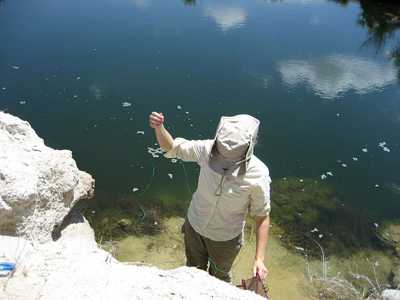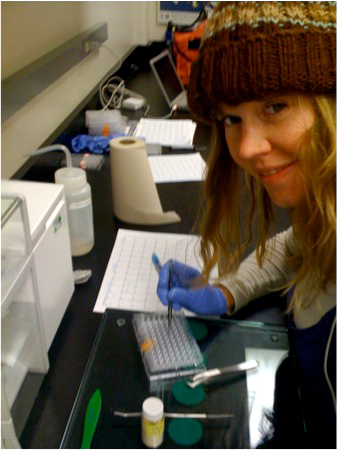Daniella Swenton , Post-Doc
Research Interests
Life-history evolution of fishes
- Patterns in reproductive allocation across environments
- Allometric constraints on allocation patterns
Aquatic ecology
- Stable isotope approaches to elucidate ecosystem patterns
- Population genetics & applications to aquatic management
- Conservation of aquatic habitat and species
Evolutionary novelty and the stress-response system
- Gene-environment regulation of stress-response
- Evolution of the stress-response system
Current & Recent Research Projects Include
Postdoctoral Research
I am broadly interested in the ecology and life-history evolution of fishes. I focus on how patterns in allocation are shaped by ecological trade-offs, particularly when contemporary environment differs from the historic, evolutionary environment. This is an increasing problem in smaller, aquatic environments (e.g. lakes, streams, ponds) that are subject to rapid change via anthropogenic inputs. Such evolutionary mismatch influences the stress-response system and can have a profound impact on female reproductive allocation and overall population dynamics such as recruitment. For my postdoctoral research I am using a variety of empirical approaches in the field and lab to characterize these life history patterns in threespine stickleback, Gasterosteus aculeatus, and use them as indicators of aquatic ecosystem change and function. Evolutionary mismatch in changing aquatic environments The post-glacial adaptive radiation of G. aculeatus provides a tractable system to study repeated, parallel evolution of divergent freshwater ecotypes. Limnetic stickleback typically inhabit oligotrophic lakes and benthic stickleback are found in eutrophic lakes. With increased eutrophication of lakes in Alaska & British Columbia, limnetic stickleback must contend with rapid change in their environment. Using benthic, limnetic and the extant, marine ancestral forms of stickleback, I examine how shifts in environment influence life history strategy of stickleback in an evolutionary framework.

I am interested in: (1) how small lakes in the Pacific NW are changing with increasing anthropogenic inputs; (2) how stress from this change influences female reproductive allocation and maternal effects; (3) how these populations may evolve in response to this environmental change; and (4) what the gene-environmental regulation of the stress-response is in this evolutionary mismatch. In collaboration with William Cresko’s lab in Oregon, we will use next generation sequencing to examine the regulation of genes found in brain and ovaries related to this stress. We hope to identify novel pathways involved in stress-response related to reproduction.
Dissertation Research
I used a variety of empirical methods to examine the ecological and behavioral factors that may contribute to premating isolation between two co-occurring species, Gambusia affinis and G. nobilis. Gambusia nobilis is endangered and characterizing threats from the highly invasive G. affinis may aid in conservation and recovery efforts for the former.
Ecological & life history divergence When two populations experience different selective environments they may also diverge in life history strategies. These divergent strategies reflect maximization of individual fitness in the face of trade-offs such as investment in offspring size or number. I found these two fishes occur in different habitat types on the refuge (Collaborator: Astrid Kodric-Brown). I characterized the aquatic habitats of the two species and found the invasive G. affinis persists in ephemeral, disturbed environments and the endangered G. nobilis is restricted to spring-fed, stenohaline and stenothermal habitats. Data collected from field caught individuals, museum specimens, and individuals in breeding experiments, show divergence in key life history traits including offspring and brood size.
A better understanding of the physical habitat requirements and competitive interactions that influence feeding niche may be helpful to management of sensitive species such as G. nobilis and its congener, Cyprinodon pecosensis (Collaborators: Thomas Kennedy & Astrid Kodric-Brown). I assessed habitats and used measures of stable isotopes (13C and 15N) for plants, macroinvertebrates and fishes to determine (1) how habitats differ and (2) how feeding niche of desert fishes. Fish assemblage size increased with water quality. There was a high degree of niche partitioning of species both within and between sites. In the presence of two or more competitors, threatened fishes fed on the edge of the available foraging space suggesting competitive displacement.
Assortative mate preference and reproductive isolation I am using microsatellite and mtDNA markers to characterize patterns in genetic variation and introgression of both species (Collaborators: Thomas F. Kennedy & Megan J. Osborne). I have found low genetic diversity for G. nobilis, probably a result of range contraction. There is evidence for strong population differentiation within and between species across sample sites. This may be explained by bottlenecks during colonization and subsequent long-term geographic isolation of these desert habitats. I identified populations with rare alleles that may be used in restocking efforts. Rates of hybridization are low suggesting strong reproductive isolation.
I examined each species’ mating preferences as a measure of reproductive isolation. Male Gambusia mostly engage in force copulation for mating opportunities. The livebearing females have a costly investment in offspring in this system and should be selected to choose an appropriate mate. Males and females of both species prefer conspecifics in visual/olfactory preference tests. This assortative pattern was held in rates of actual copulation.
Send Daniella an email at dswenton@clarku.edu
